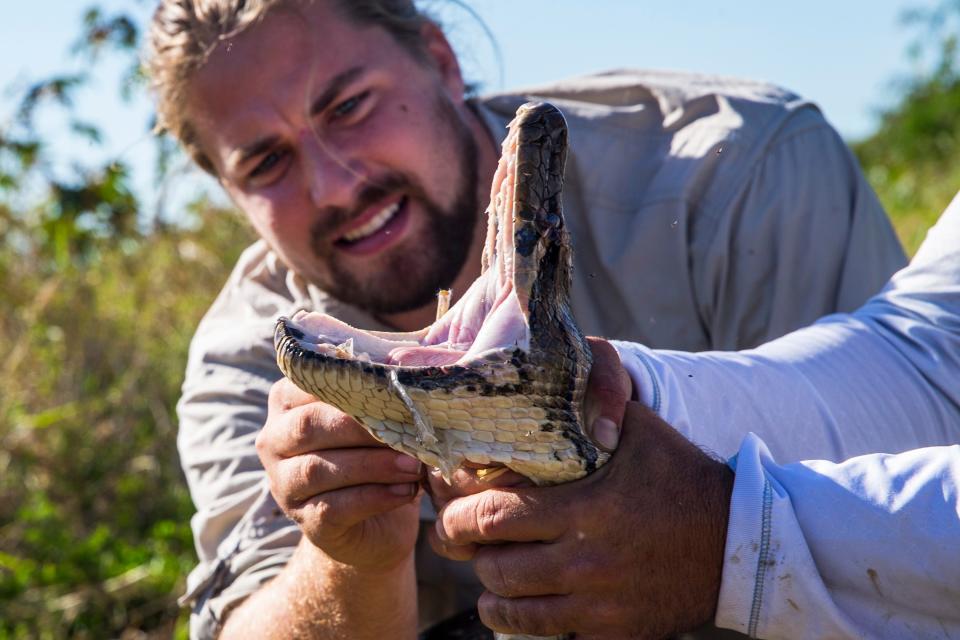The Burmese python is already considered a destructive force in the South Florida ecosystem. A new collaborative study that the Conservancy of Southwest Florida in Naples was part of has revealed things are worse than experts thought when it comes to the size of the prey of the invasive Burmese python.
This means more animals are on the menu across southern Florida, where the pythons have decimated populations of foxes, bobcats, raccoons and other animals.
Pythons swallow deer, alligators and other prey whole. What they can eat is limited to and dependent on how big the Burmese python’s mouth opening can stretch. Researchers call this the snake’s gape.
More: Python challenge: Why state recommends not eating Florida pythons
What gives pythons the ability to eat such large animals is their incredible mouths. The lower jawbones are not fused at the front, allowing the jaws to stretch wide. Their skin is also elastic that it accounts for more than half the circumference of the maximal gape in large pythons, allowing the snakes to consume prey six times larger than similar-sized snakes of some other snake species.
-
Conservancy of Southwest Florida Biologists Ian Bartoszek and Ian Easterling recently conducted a study in collaboration with Dr. Bruce Jayne from the Department of Biological Science at the University of Cincinnati, Ohio, to better understand the ecological impacts of the invasive Burmese python. The team measured the greatest maximum gape recorded in Burmese pythons to date.
-
Jayne said measurements of the longest Burmese python (19 feet) and two other very large snakes (15 and 17 feet) captured in South Florida show that the pythons have a gape bigger than even previous mathematical models would suggest.
-
Previous studies of pythons found the largest gape diameter was 22 centimeters (8.7 inches). But the big snakes in the current study by Jayne, Bartoszek and Easterling had a maximal gape of 26 centimeters (10.2 inches). These measurements equate to a circumference of 32 inches.
-
Knowing the limits on the size of prey that predators can eat can help researchers predict the ecological impact the invasive snakes might have as they move into new areas.
Plenty of pythons: What is a ball python? Here’s an explainer on the ‘nice cousin’ to the Burmese

What pythons were used for the gape study?
Three large adult female Burmese pythons researched at the Conservancy were examined and used for the data and observations of this study, including the longest documented capture on record. One python measured for data was found by Conservancy biologists while it was ingesting a 77 pound (35-kg) white-tailed deer. The deer was 66.9% of the snake’s mass.
“Watching an invasive apex predator swallow a full-sized deer in front of you is something that you will never forget. The impact the Burmese python is having on native wildlife cannot be denied. This is a wildlife issue of our time for the Greater Everglades ecosystem,” Bartoszek said.
““Besides the large absolute size of the deer that was eaten being impressive, our anatomical measurements indicate this deer was very near the size limit on the prey that could be consumed by this snake. Hence, these snakes resemble overachievers by sometimes testing the limits of what their anatomy allows rather than being slackers that eat only ‘snack size’ prey,” Jayne said.


Python research and the Conservancy of Southwest Florida
The Conservancy of Southwest Florida’s primary objective is to create a database of behavior and habitat use to better understand python activity. This research helps to inform decision-makers, other biologists, and land managers to develop a control strategy on the apex predator.
-
The Conservancy began its Burmese python research and removal efforts within the bio-region in 2013.
-
As of October 2024, the team has removed over 36,000 pounds (18 tons) of python from an approximately 150-square-mile area in Southwest Florida.
-
Using radio telemetry fieldwork to document behavior and biology, 120 adult Burmese pythons (known as scout snakes) have been radio tagged and tracked to better understand the invasive population.
-
The Conservancy of Southwest Florida’s primary objective is to create a database of behavior and habitat use to better understand python activity. This research helps to inform decision-makers, other biologists, and land managers to develop a control strategy on the apex predator.
This article originally appeared on Palm Beach Post: How big is a Burmese python’s mouth? How large a prey can they eat?
EMEA Tribune is not involved in this news article, it is taken from our partners and or from the News Agencies. Copyright and Credit go to the News Agencies, email news@emeatribune.com Follow our WhatsApp verified Channel




